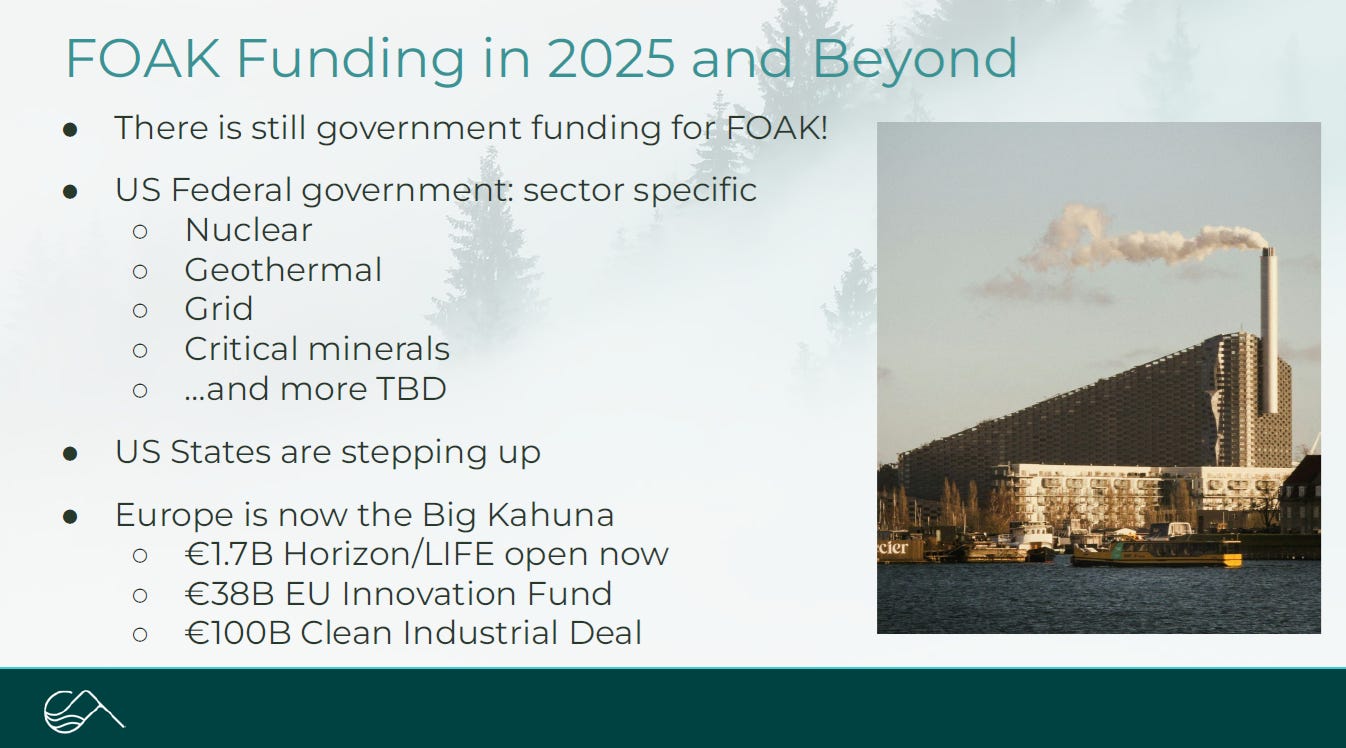This is CC Insights: Perspectives from Climate Capital. You are receiving this because you have subscribed to our Substack. Upgrade to CC+ for insider access & community or manage your subscription here.
Before we dive in: Climate Angels, CC Network Fund, & CC Syndicate
Whether you’re new to climate investing or a veteran, 3 opportunities for you:
→ Join Climate Angels. 3 top tier sessions/month with veteran investors & angel peers; apply by July 7 for 10% off. In July: Thesis deep dive, Dimitry Gershenson (Enduring Planet) and Austin Badger (HSBC) on non-dilutive potential, and more. Register Here
→ Back the CC Network Fund. So far in Q2 the fund has invested in 13 companies including Alta, reinventing critical minerals mining using biochemistry, and LGND which builds integrated services for developers and analysts to create, tune, store, and serve geographic embeddings.
→ Back the CC Syndicate. SPVs with investment minimums starting at $1k.
Webinar Recap: Understanding the FOAK Project Capital Stack
In a recent webinar hosted by Climate Capital, we welcomed Joel Armin Hoiland, Founder and CEO of Climate Finance Solutions (CFS), to discuss the current landscape of funding for first-of-a-kind (FOAK) projects. With over $1.6 billion in government grants secured, Joel provided insights into the evolving funding environment, particularly in the context of climate technology.
Missed the webinar? Access recording here
What's Changing in Climate Funding?
Historically, around $28 billion per year was allocated to climate through normal appropriations. However, recent legislation, including the Inflation Reduction Act (IRA) and the Bipartisan Infrastructure Law (BIL), has increased federal spending to approximately $110 billion annually. This funding is crucial for supporting projects across the entire lifecycle of companies, especially for FOAK initiatives.
Despite the substantial funding available, recent changes in the federal administration have introduced uncertainty. The Office of Clean Energy Demonstrations (OCED) is undergoing significant downsizing, with many grants being canceled. However, while the landscape is shifting, opportunities for funding still exist, particularly for projects aligned with the administration's priorities, such as nuclear, geothermal, and critical minerals.
Tips for Savvy Investors
For early-stage investors, understanding how to support their portfolio companies in securing FOAK financing is essential. One way to do this is by encouraging companies to explore alternative sources of finance and not abandon grant opportunities. Even with fewer federal grants available, there is still a wealth of funding options that companies can tap into.
Investors should look for specific signals when assessing a company's potential for securing government grants. Key indicators include:
Relevance of Technology: The technology should have a clear potential for system-level decarbonization.
Clear Use Case: Companies should articulate a clear use case for FOAK projects, even if they lack an anchor partner at the early stages.
Technical Readiness: Companies should demonstrate a defined path toward achieving a Technology Readiness Level (TRL) of 7-9.
Alignment with Public Policy: Companies should align their projects with current public policy priorities to enhance their chances of securing funding.
Watch Out for These Red Flags
There are also common pitfalls that can hinder a company's ability to secure FOAK financing. These include:
Lack of Strategic Planning: Companies that approach funding opportunistically without a comprehensive understanding of the funding ecosystem may miss out on the best opportunities.
Misalignment of Timelines: Understanding the lengthy timelines associated with grant applications and funding disbursement is crucial. Many companies fail to account for the time it takes to secure grants, leading to misaligned expectations.
Insufficient Internal Capacity: Companies need to have the expertise to manage grants effectively. This may involve hiring consultants or building internal capacity to navigate the complexities of grant applications.
Exploring Global Opportunities
As the U.S. funding landscape becomes more restrictive, companies are increasingly looking to Europe for funding opportunities. The EU Innovation Fund, which allocates significant resources for FOAK projects, is one avenue where U.S. companies can find support. The fund has a strong focus on large-scale commercial demonstrations, making it a vital resource for companies seeking substantial funding.
Wrapping It Up
In today’s climate, it is necessary to be adaptable and have strategic foresight in navigating the funding landscape. As government priorities evolve, both investors and companies must stay alert and proactive in identifying funding opportunities. By grasping the intricacies of the capital stack and utilizing both domestic and international resources, stakeholders can effectively position themselves for success in the dynamic climate tech sector.
For additional insights and resources, Climate Finance Solutions provides webinars and personalized strategy sessions for investors and their portfolio companies, promoting a collaborative approach to securing funding in this vital industry.
Learn more about CFS at http://www.climatefinancesolutions.com.
––
Note: The Author’s opinions are their own and not necessarily representative of Climate Capital.
Disclaimer: Under no circumstances should any information or content in this email be considered an offer to sell or solicitation of interest to purchase any securities, including any securities advised by Climate Capital or any of its affiliates or representatives. Further, no content or information herein is or is intended, nor should it be construed as, an offer to provide any investment advisory service, financial advice, legal, tax, accounting, investment, or other advice from Climate Capital or any of its affiliates (collectively "Climate Capital”). Under no circumstances should anything herein be construed as fund marketing materials by prospective investors considering investing in any Climate Capital investment fund. Content contained herein does not constitute an offer to sell — or a solicitation of an offer to buy — any securities and may not be used or relied upon in evaluating the merits of any investment. Information regarding companies highlighted herein has been provided by third parties, and Climate Capital makes no representations or warranties as to its accuracy, as to the viability of any company listed herein, or the results of any investment in a listed company.






